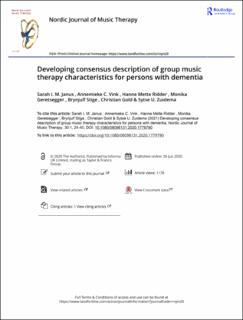| dc.contributor.author | Janus, Sarah I.M. | |
| dc.contributor.author | Vink, Annemiek | |
| dc.contributor.author | Ridder, Hanne Mette | |
| dc.contributor.author | Geretsegger, Monika | |
| dc.contributor.author | Stige, Brynjulf | |
| dc.contributor.author | Gold, Christian | |
| dc.contributor.author | Zuidema, Sytse | |
| dc.date.accessioned | 2021-02-01T14:34:26Z | |
| dc.date.available | 2021-02-01T14:34:26Z | |
| dc.date.created | 2020-08-25T22:55:52Z | |
| dc.date.issued | 2020 | |
| dc.identifier.citation | Nordic journal of music therapy. 2020, 24-40. | en_US |
| dc.identifier.issn | 0809-8131 | |
| dc.identifier.uri | https://hdl.handle.net/11250/2725642 | |
| dc.description.abstract | Introduction
Group music therapy (GMT) represents a promising person-centered approach facilitating emotional and social interaction and alleviating behavioral and psychological symptoms in people with dementia. The aim of this study is to produce a consensus statement that can inform provision of and research on person-centered group music therapy (GMT) for persons with dementia.
Method
We used a Delphi consensus procedure of two iterations in which music therapists rated their agreement with predefined statements about descriptions of GMT in structured questionnaires. Music therapists from eight countries (Austria, Australia, Denmark, Germany, Italy, Netherlands, Norway and UK) participated in the Delphi iterations.
Results
In the first iteration 57 music therapists participated and 34 in the second iteration. Consensus was reached on 75 out of 91 statements covering five themes: (1) People who can benefit from GMT, (2) Short and long-term goals, (3) Therapy frame & Assessment (4) Therapeutic approaches within GMT and (5) Therapists’ qualities and attitudes.
Discussion
This consensus statement provides therapists and researchers with practical information to which music therapists agree on an international level. It may serve as a foundation for developing more extensive and in-depth guidelines and fidelity measures. The statements underlinethat the music therapist must adapt therapy to the needs and wishes of persons with dementia, which can be seen in the consensus statements about group size, group dynamics, distractions and interruptions during the therapy. | en_US |
| dc.language.iso | eng | en_US |
| dc.rights | Attribution-NonCommercial-NoDerivatives 4.0 Internasjonal | * |
| dc.rights.uri | http://creativecommons.org/licenses/by-nc-nd/4.0/deed.no | * |
| dc.title | Developing consensus description of group music therapy characteristics for persons with dementia | en_US |
| dc.type | Peer reviewed | en_US |
| dc.type | Journal article | en_US |
| dc.rights.holder | © 2020, Authors | |
| dc.description.version | publishedVersion | en_US |
| cristin.ispublished | true | |
| cristin.fulltext | original | |
| cristin.qualitycode | 1 | |
| dc.identifier.doi | 10.1080/08098131.2020.1779790 | |
| dc.identifier.cristin | 1825159 | |
| dc.source.journal | Nordic journal of music therapy | en_US |
| dc.source.pagenumber | 24-40 | en_US |

